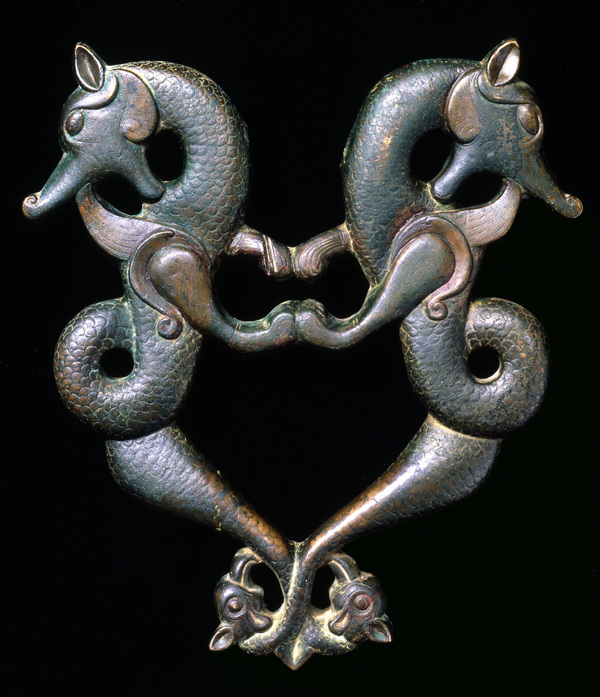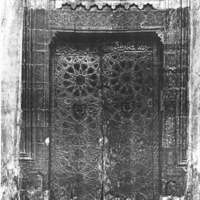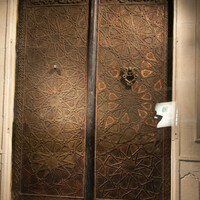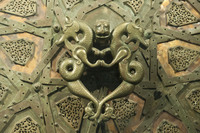Door knockers from Cizre
Type:
Doors,
Mosques,
Sculptures
Date:
First half of thirteenth century
Location or Findspot (Modern-Day Country):
Turkey
Medium:
Bronze
Dimensions:
Istanbul: 27 × 24 × 3 cm; Copenhagen: 27.5 x 24.5 cm
Description:
The Ülü Camii—Turkish for masjid al-jami')—at Cizre, a town on the Tigris River known in the Middle Ages as Jazirat ibn ʿUmar, was built in 1155–60. It probably received its tall double doors, made of bronze panels nailed to wood, in the first half of the thirteenth century; a fragmentary inscription atop the doors refers to Mahmud Sanjar Shah, the atabeg (provincial ruler) of Cizre between 1208 and 1241.
The Cizre doors were outfitted with two cast-bronze knockers; one is now in Istanbul, still attached to the doors, and parts of the other are in Copenhagen. The door knockers are in the form of two winged dragons flanking a lion's-head hinge; each dragon's tail terminates in an eagle's head. Such apotropaic creatures were often represented on building exteriors in the Islamicate world (and beyond), as in the Citadel of Aleppo, the Talisman Gate at Baghdad, and the Ülü Camii in Diyarbakır. The knotlike forms of the intertwined Cizre dragons, combined with the loud sound they produced, further served to ward off evil.
A very similar design for door knockers for a now-lost palace at Amid (now Diyarbakır) is preserved in a manuscript of ingenious mechanical devices made in 1206, and a poem by Nizami (d. 1209) records a serpent-shaped door knocker at the Ka'ba in Mecca. Additional extant examples are in European collections.
The Cizre doors were outfitted with two cast-bronze knockers; one is now in Istanbul, still attached to the doors, and parts of the other are in Copenhagen. The door knockers are in the form of two winged dragons flanking a lion's-head hinge; each dragon's tail terminates in an eagle's head. Such apotropaic creatures were often represented on building exteriors in the Islamicate world (and beyond), as in the Citadel of Aleppo, the Talisman Gate at Baghdad, and the Ülü Camii in Diyarbakır. The knotlike forms of the intertwined Cizre dragons, combined with the loud sound they produced, further served to ward off evil.
A very similar design for door knockers for a now-lost palace at Amid (now Diyarbakır) is preserved in a manuscript of ingenious mechanical devices made in 1206, and a poem by Nizami (d. 1209) records a serpent-shaped door knocker at the Ka'ba in Mecca. Additional extant examples are in European collections.
Relevant Textbook Chapter(s):
8
Repository and Online Resources:
• The David Collection, Copenhagen, inv. no. 38/1973; photo Pernille Klemp
• Discover Islamic Art database
Image Credits:
Wikimedia Commons; Flickr





